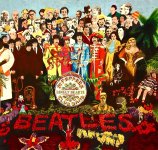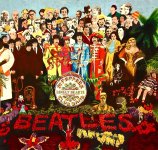Rock music is not just about the music itself, it's about the complete experience. From the stage presence of the band to the design of their album covers, everything is a part of the package that makes rock music so captivating. Album art is a crucial component of this experience, often acting as a visual representation of the music and the band itself. In this article, we will explore the importance of album art in rock music and take a visual journey through its history.
Album art has been a part of the music industry since the early 20th century. However, it wasn't until the 1960s and 70s, during the rise of rock music, that album art truly began to be considered a work of art. Bands like the Beatles, Pink Floyd, and Led Zeppelin, all known for their iconic album covers, helped to elevate the importance of album art in rock music.
The Beatles' album covers were often bright and colorful, featuring the band members in various poses and settings. One of their most famous album covers, Sgt. Pepper's Lonely Hearts Club Band, features the band dressed in elaborate costumes, surrounded by a variety of famous figures and objects. This album cover was not just a visual representation of the music, but also a statement about the band's creativity and artistic vision.
Pink Floyd is another band that is well-known for their album art. The cover of their album Dark Side of the Moon is instantly recognizable, featuring a prism refracting light into a rainbow. This cover perfectly encapsulates the album's themes of life, death, and everything in between.
Led Zeppelin's album covers were often a reflection of the band's mystical and mythical persona. The cover of their fourth album, commonly referred to as Led Zeppelin IV, features an image of an old man carrying a bundle of sticks on his back. This image is a representation of the album's themes of strength, wisdom, and perseverance.
As rock music continued to evolve, so did album art. In the 1980s, album covers began to take on a more modern and electronic feel. Bands like Duran Duran and Depeche Mode often used graphic design and photography to create their album covers. The cover of Duran Duran's album Rio, for example, features a photograph of a model wearing a bikini and a bright red lipstick. This cover perfectly encapsulates the glitz and glamour of the 1980s.
In the 1990s, grunge music brought a new wave of album art. Bands like Nirvana and Soundgarden often used gritty and distorted images to reflect their music's raw and powerful sound. Nirvana's album covers were particularly famous for their minimalistic and thought-provoking design. The cover of their album Nevermind, for example, features a baby swimming towards a dollar bill on a fishing line. This cover was a statement on the consumerism and commercialization of the music industry.
In conclusion, album art is an essential component of rock music. It helps to create a complete and immersive experience for the listener, offering a visual representation of the music and the band's artistic vision. From the colorful and elaborate covers of the Beatles to the gritty and raw images of Nirvana, album art has evolved alongside rock music, becoming a vital part of its history and culture.
Album art has been a part of the music industry since the early 20th century. However, it wasn't until the 1960s and 70s, during the rise of rock music, that album art truly began to be considered a work of art. Bands like the Beatles, Pink Floyd, and Led Zeppelin, all known for their iconic album covers, helped to elevate the importance of album art in rock music.
The Beatles' album covers were often bright and colorful, featuring the band members in various poses and settings. One of their most famous album covers, Sgt. Pepper's Lonely Hearts Club Band, features the band dressed in elaborate costumes, surrounded by a variety of famous figures and objects. This album cover was not just a visual representation of the music, but also a statement about the band's creativity and artistic vision.
Pink Floyd is another band that is well-known for their album art. The cover of their album Dark Side of the Moon is instantly recognizable, featuring a prism refracting light into a rainbow. This cover perfectly encapsulates the album's themes of life, death, and everything in between.
Led Zeppelin's album covers were often a reflection of the band's mystical and mythical persona. The cover of their fourth album, commonly referred to as Led Zeppelin IV, features an image of an old man carrying a bundle of sticks on his back. This image is a representation of the album's themes of strength, wisdom, and perseverance.
As rock music continued to evolve, so did album art. In the 1980s, album covers began to take on a more modern and electronic feel. Bands like Duran Duran and Depeche Mode often used graphic design and photography to create their album covers. The cover of Duran Duran's album Rio, for example, features a photograph of a model wearing a bikini and a bright red lipstick. This cover perfectly encapsulates the glitz and glamour of the 1980s.
In the 1990s, grunge music brought a new wave of album art. Bands like Nirvana and Soundgarden often used gritty and distorted images to reflect their music's raw and powerful sound. Nirvana's album covers were particularly famous for their minimalistic and thought-provoking design. The cover of their album Nevermind, for example, features a baby swimming towards a dollar bill on a fishing line. This cover was a statement on the consumerism and commercialization of the music industry.
In conclusion, album art is an essential component of rock music. It helps to create a complete and immersive experience for the listener, offering a visual representation of the music and the band's artistic vision. From the colorful and elaborate covers of the Beatles to the gritty and raw images of Nirvana, album art has evolved alongside rock music, becoming a vital part of its history and culture.
Attachments
Last edited:







